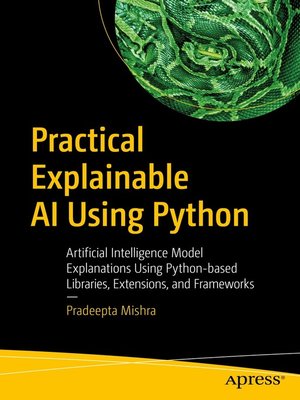Practical Explainable AI Using Python
ebook ∣ Artificial Intelligence Model Explanations Using Python-based Libraries, Extensions, and Frameworks
By Pradeepta Mishra

Sign up to save your library
With an OverDrive account, you can save your favorite libraries for at-a-glance information about availability. Find out more about OverDrive accounts.
Find this title in Libby, the library reading app by OverDrive.



Search for a digital library with this title
Title found at these libraries:
| Loading... |
Learn the ins and outs of decisions, biases, and reliability of AI algorithms and how to make sense of these predictions. This book explores the so-called black-box models to boost the adaptability, interpretability, and explainability of the decisions made by AI algorithms using frameworks such as Python XAI libraries, TensorFlow 2.0+, Keras, and custom frameworks using Python wrappers.
You'll begin with an introduction to model explainability and interpretability basics, ethical consideration, and biases in predictions generated by AI models. Next, you'll look at methods and systems to interpret linear, non-linear, and time-series models used in AI. The book will also cover topics ranging from interpreting to understanding how an AI algorithm makes a decision
Further, you will learn the most complex ensemble models, explainability, and interpretability using frameworks such as Lime, SHAP, Skater, ELI5, etc. Moving forward, youwill be introduced to model explainability for unstructured data, classification problems, and natural language processing–related tasks. Additionally, the book looks at counterfactual explanations for AI models. Practical Explainable AI Using Python shines the light on deep learning models, rule-based expert systems, and computer vision tasks using various XAI frameworks.
What You'll LearnReview the different ways of making an AI model interpretable and explainable Examine the biasness and good ethical practices of AI models Quantify, visualize, and estimate reliability of AI models Design frameworks to unbox the black-box models Assess the fairness of AI models
Understand the building blocks of trust in AI models
Increase the level of AI adoption
Who This Book Is For
AI engineers, data scientists, and software developers involved in driving AI projects/ AI products.
You'll begin with an introduction to model explainability and interpretability basics, ethical consideration, and biases in predictions generated by AI models. Next, you'll look at methods and systems to interpret linear, non-linear, and time-series models used in AI. The book will also cover topics ranging from interpreting to understanding how an AI algorithm makes a decision
Further, you will learn the most complex ensemble models, explainability, and interpretability using frameworks such as Lime, SHAP, Skater, ELI5, etc. Moving forward, youwill be introduced to model explainability for unstructured data, classification problems, and natural language processing–related tasks. Additionally, the book looks at counterfactual explanations for AI models. Practical Explainable AI Using Python shines the light on deep learning models, rule-based expert systems, and computer vision tasks using various XAI frameworks.
What You'll Learn
Who This Book Is For
AI engineers, data scientists, and software developers involved in driving AI projects/ AI products.






